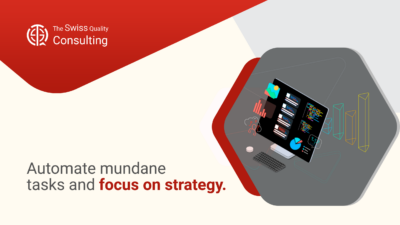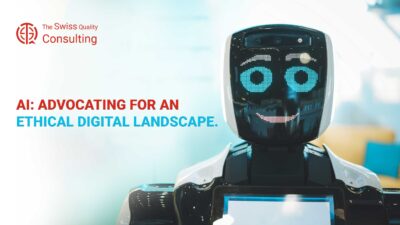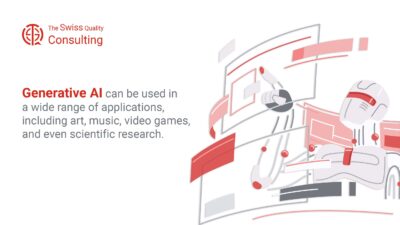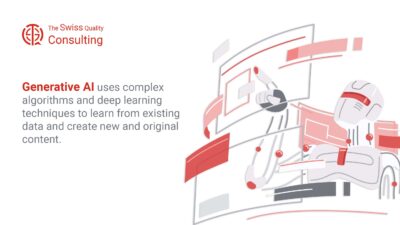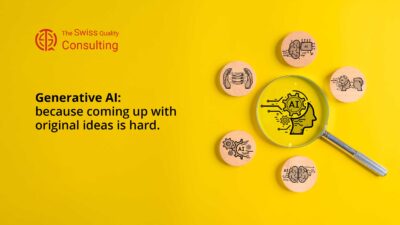Understanding and Harnessing the Power of Creative AI
In the realm of business technology, the quote “Ungezähmte Kreative KI ähnelt Terminator” provocatively captures the essence of a common apprehension: the fear of uncontrolled Generative Artificial Intelligence (AI). While the comparison to the fictional world of the ‘Terminator’ is metaphorical, it underscores the vital importance of effectively managing creative AI in the corporate sector.
The Reality of Generative AI in Business
Generative Artificial Intelligence (AI) is rapidly transforming the business landscape with its extraordinary capabilities for innovation and efficiency. This cutting-edge technology is not just automating mundane and routine tasks; it’s also paving the way for groundbreaking ideas and solutions that were once thought impossible. Businesses across various sectors are leveraging Generative AI to enhance their operations, develop new products, and personalize customer experiences in ways that significantly boost productivity and creativity.
The potential of Generative AI is immense and multifaceted. In marketing, for instance, it can create highly targeted content that resonates with specific audience segments, while in product development, it can generate innovative design alternatives that accelerate the creative process. In customer service, AI can provide personalized assistance to customers, improving satisfaction and loyalty. The efficiency gains from these applications are substantial, allowing businesses to allocate human resources to more complex and strategic tasks.
However, the power of Generative AI, like any advanced tool, comes with significant responsibilities. Proper control and utilization are critical to ensuring that this technology benefits businesses and society as a whole. The dramatic ‘Terminator’ scenario, though metaphorical, serves as a stark reminder of the potential consequences of uncontrolled technology. Without established boundaries and ethical guidelines, there’s a risk that AI could make decisions that are detrimental to human interests or operate in ways that are unpredictable and potentially harmful.
This necessitates a robust framework for AI governance within organizations. Businesses must develop and adhere to strict ethical guidelines and best practices to ensure that AI is used in a way that aligns with both business objectives and societal norms. This includes being transparent about how AI is used, especially in areas like data collection and analysis, and ensuring that AI-driven decisions are explainable and accountable.
In conclusion, while Generative AI presents a frontier of limitless possibilities, it is imperative that businesses approach its implementation with a strategic mindset focused on control, ethics, and responsible use. Only by doing so can they harness the full potential of AI to drive innovation and efficiency, while safeguarding against the risks of unchecked technological power.
Setting Boundaries and Ethical Guidelines
For business leaders, the primary goal is not to shun or fear AI, but to establish robust frameworks that guide its use. This involves setting clear boundaries, developing ethical guidelines, and ensuring that AI implementations align with business values and objectives.
Integrating AI into Change Management and Leadership
Change Management: As businesses undergo digital transformation, integrating AI into their operations, effective change management becomes crucial. Leaders must guide their teams through these changes, ensuring a smooth transition that leverages AI’s benefits while mitigating risks.
Executive Coaching for AI Readiness
Executive coaching plays a vital role in preparing leaders for the AI era. It involves developing an understanding of AI capabilities, fostering a culture of innovation, and building skills to manage AI-driven changes effectively.
Effective Communication in the Age of AI
AI’s role in communication is twofold: enhancing business messaging and necessitating transparent communication about AI’s use. Leaders must ensure that AI tools are used to improve, not hinder, clear and authentic communication within and outside the organization.
Building a Sustainable AI Strategy
Sustainable AI strategy involves aligning AI initiatives with long-term business goals and ethical standards. It requires ongoing evaluation and adaptation to ensure AI’s role in the business remains positive and productive.
#GenerativeAI #BusinessTechnology #ChangeManagement #AIinLeadership #EthicalAI #DigitalTransformation #ExecutiveCoaching #EffectiveCommunication #AIStrategy #InnovativeBusiness













